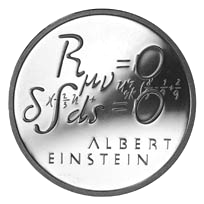| General relativity |
|---|
 |
In the general theory of relativity, the Einstein field equations (EFE; also known as Einstein's equations) relate the geometry of spacetime to the distribution of matter within it. [1]
Contents
- Mathematical form
- Sign convention
- Equivalent formulations
- Cosmological constant
- Features
- Conservation of energy and momentum
- Nonlinearity
- Correspondence principle
- Vacuum field equations
- Einstein–Maxwell equations
- Solutions
- Linearized EFE
- Polynomial form
- See also
- Notes
- References
- External links
- External images
The equations were published by Albert Einstein in 1915 in the form of a tensor equation [2] which related the local spacetime curvature (expressed by the Einstein tensor) with the local energy, momentum and stress within that spacetime (expressed by the stress–energy tensor). [3]
Analogously to the way that electromagnetic fields are related to the distribution of charges and currents via Maxwell's equations, the EFE relate the spacetime geometry to the distribution of mass–energy, momentum and stress, that is, they determine the metric tensor of spacetime for a given arrangement of stress–energy–momentum in the spacetime. The relationship between the metric tensor and the Einstein tensor allows the EFE to be written as a set of nonlinear partial differential equations when used in this way. The solutions of the EFE are the components of the metric tensor. The inertial trajectories of particles and radiation (geodesics) in the resulting geometry are then calculated using the geodesic equation.
As well as implying local energy–momentum conservation, the EFE reduce to Newton's law of gravitation in the limit of a weak gravitational field and velocities that are much less than the speed of light. [4]
Exact solutions for the EFE can only be found under simplifying assumptions such as symmetry. Special classes of exact solutions are most often studied since they model many gravitational phenomena, such as rotating black holes and the expanding universe. Further simplification is achieved in approximating the spacetime as having only small deviations from flat spacetime, leading to the linearized EFE. These equations are used to study phenomena such as gravitational waves.


























































